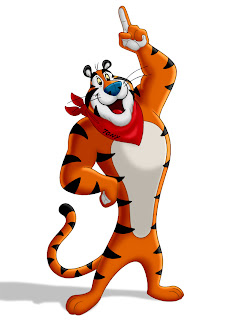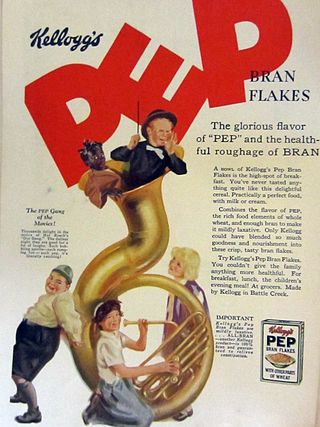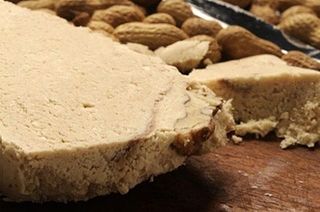
Breakfast cereal is a breakfast food made from processed cereal grains. It is traditionally eaten as part of breakfast, or a snack food, primarily in Western societies.

Nabisco is an American manufacturer of cookies and snacks headquartered in East Hanover, New Jersey. The company is a subsidiary of Illinois-based Mondelēz International.

Kellanova is an American multinational food manufacturing company headquartered in Chicago, Illinois, United States. Kellogg's produces cereal and convenience foods, including crackers and toaster pastries, and markets their products by several well-known brands including the Kellogg's brand itself, Rice Krispies Treats, Pringles, Eggo, and Cheez-It, along with cereal internationally such as Corn Flakes, Rice Krispies, Frosties and Coco Pops.

Corn Pops is a puffed grain breakfast cereal made by Kellogg's, described by the company as "crunchy sweetened popped-up corn cereal." The cereal was introduced in 1950 as "Corn Pops". In 1951, the name was changed to "Sugar Corn Pops" and later to "Sugar Pops". It was the sponsor for The Adventures of Wild Bill Hickok radio and television show. The name was changed back to 'Sugar Corn Pops' in 1978, and finally returned to 'Corn Pops' in 1984, a time when many cereals dropped the word "sugar" from their titles for marketing reasons. In January 2006, the name of the cereal was changed to 'Pops', but after a few months of poor reception was changed back to Corn Pops.

Cheerios is a brand of cereal manufactured by General Mills in the United States and Canada, consisting of pulverized oats in the shape of a solid torus. In some countries, including the United Kingdom, Cheerios is marketed by Cereal Partners under the Nestlé brand; in Australia and New Zealand, Cheerios is sold as an Uncle Tobys product. It was first manufactured in 1941 as CheeriOats.

Jif is an American brand of peanut butter made by The J.M. Smucker Company, which purchased the brand from Procter & Gamble in 2001.

Tony the Tiger is the advertising cartoon anthropomorphic tiger mascot for WK Kellogg Co's Frosted Flakes breakfast cereal, appearing on its packaging and advertising. Tony has also been the mascot for related cereals such as Tony's Cinnamon Krunchers and Tiger Power. Since Tony's debut in 1952, the character has spanned several generations and has become a breakfast cereal icon.
Post Consumer Brands is an American consumer packaged goods food manufacturer headquartered in Lakeville, Minnesota.

Golden Crisp, also known as Sugar Crisp in Canada, is a brand of breakfast cereal made by Post Consumer Brands that consists of sweetened, candy-coated puffed wheat and is noted for its high sugar content. It was introduced in the United States in 1948.

A fluffernutter is a sandwich made with peanut butter and marshmallow creme usually served on white bread. Variations of the sandwich include the substitution of wheat bread and the addition of various sweet, salty, and savory ingredients. The term fluffernutter can also be used to describe other food items, primarily desserts, that incorporate peanut butter and marshmallow creme.

Chex is an American brand of breakfast cereal currently manufactured by General Mills. It was originally known as Shredded Ralston, first produced in 1936 and owned by Ralston Purina of St. Louis, Missouri, then later renamed Chex in 1950. The Chex brand went with corporate spinoff Ralcorp in 1994 and was then sold to General Mills in 1997. Rival cereal company Kellogg's has the rights to the Chex brand in South Korea and Singapore.

Shredded wheat is a breakfast cereal made from whole wheat formed into pillow-shaped biscuits. It is commonly available in three sizes: original, bite-sized and miniature. Both smaller sizes are available in a frosted variety, which has one side coated with sugar and usually gelatin. Some manufacturers have produced "filled" versions of the bite-size cereal containing a raisin at the center, or apricot, blueberry, raspberry, cherry, cranberry or golden syrup filling.

Force was the first commercially successful wheat flake breakfast cereal. Prior to this, the only successful wheat-based cereal products had been Shredded Wheat and the hot semolina cereal, Cream of Wheat. The product was cheap to produce and kept well on store shelves. First produced in 1901 by the Force Food Company in Buffalo, New York, it was one of three companies owned by Edward Ellsworth and advertised using a popular cartoon figure called Sunny Jim.

Chex Mix is a type of snack mix that includes Chex breakfast cereal as a major component.

MOM Brands Company was an American producer of breakfast cereals, headquartered in Northfield, Minnesota. It marketed its products in at least 70% of the country's grocery stores, with estimated sales in 2012 of US$750 million. It operated four manufacturing plants, in Northfield, Minnesota; Tremonton, Utah; Asheboro, North Carolina; and St. Ansgar, Iowa. The company had distribution centers in Grove City, Ohio; Coppell, Texas; and Salt Lake City, Utah.

Pep was a brand of whole-wheat breakfast cereal produced by the Kellogg Company, and introduced in 1923, which became the first to be fortified with vitamins B and D in 1938. Pep was a long-running rival to Wheaties, and also the sponsor of Mutual Radio's The Adventures of Superman radio series. One of Pep's advertising slogans was "the Sunshine cereal".

Mantecol is the brand name of a typical dessert of the cuisine of Argentina, a sort of semi-soft nougat made from peanut butter. It was originally created and marketed in the 1940s by the confectionery company Georgalos, founded by a Greek immigrant, Miguel Georgalos, who took the inspiration in a dessert of Greek cuisine, the halva.

Bagrrys India Limited is an Indian multinational FMCG food-manufacturing company which manufactures the high-fiber breakfast cereals and health foods, headquartered in New Delhi, India. The company has two food brands in its portfolio ‘Bagrry's’ and ‘Lawrence Mills’.

WK Kellogg Co is an American food manufacturing company, split from Kellogg's on October 2, 2023 and is headquartered in Battle Creek, Michigan. It was formed in October 2023 as part of Kellogg's hive-off of its North American cereal business.



















